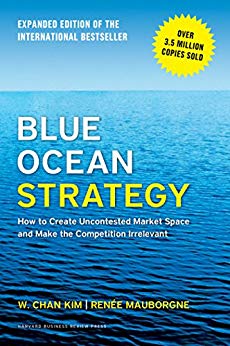

This article is an excerpt from the Shortform summary of "Blue Ocean Strategy" by W. Chan Kim and Renee Mauborgne. Shortform has the world's best summaries of books you should be reading.
Like this article? Sign up for a free trial here .
What is value innovation? How do Kim and Mauborgne define “value innovation” in the context of blue ocean strategy?
Value innovation is the cornerstone of Kim and Mauborgne’s blue ocean strategy. The authors clarify that blue ocean innovation is not a matter of merely raising or lowering value in order to raise or lower your costs. Instead, Kim and Mauborgne assert that you need a breakthrough that allows you to offer better value at a lower cost.
Keep reading to learn about the concept of blue ocean innovation (or “value innovation”) and how it creates blue oceans through new ideas that redefine the market.
Innovation Is the Key to Blue Ocean Strategy
Kim and Mauborgne argue that a blue ocean strategy starts with what they call “value innovation”—an innovation that makes your product so unique and superior to the competition (and thus more valuable to your customers) that you open up uncontested markets and leave your rivals behind. In this case, value is the benefit that your customers get for their money, while innovation is the uniqueness and originality of the benefit. To be effective, value and innovation are both required. By contrast:
- Value creation without innovation tends to mean incremental improvements. For instance, decreasing costs and prices by 2% can create a lot of value, but it doesn’t lead to a new market space and differentiation.
- Innovation without value creation tends to create unique high-tech products that nobody wants to buy.
(Shortform note: Kim and Mauborgne coined the term “value innovation” in a 1997 article in which they explored the ideas that Blue Ocean Strategy was later based on—that companies must innovate beyond their currently defined borders in order to stay ahead of their competition. The term has been widely adopted by strategy and management experts since and is firmly associated with their theories.)
Typically, this “blue ocean innovation” involves adding value by creating new features that buyers want, while cutting costs by reducing or eliminating features they don’t care as much about, resulting in a unique offering.
(Shortform note: In Purple Cow (published two years before Blue Ocean Strategy), Seth Godin argues that only remarkable products are likely to succeed, because people are bombarded with advertisements for so many unremarkable things that they’ve learned to ignore them. He goes on to clarify that to be remarkable, a product must be both unique enough to stand out from the crowd, and also practical enough that people want to buy it. This is nearly the same distinction that Kim and Mauborgne make in contrasting blue ocean innovation with “value without innovation” and “innovation without value.”)
What Blue Ocean Innovation Isn’t
The authors clarify that blue ocean innovation is not a matter of merely raising or lowering value in order to raise or lower your costs (which will then raise or lower the price you charge your customers). It’s easy to add premium features and offer a higher-value product at a higher price, or cut features to offer an economy version at a lower price, but that doesn’t require innovation. Instead, Kim and Mauborgne assert that you need a breakthrough that allows you to offer better value at lower cost.
To illustrate how a company can successfully implement a blue ocean strategy, Kim and Mauborgne discuss the Canadian company Cirque du Soleil (“Circus of the Sun”), which created a blue ocean for itself by redefining circus entertainment. They took some of the most popular types of circus acts, such as clowns and acrobatics, and wove these acts together with elements of theater into a coherent performance with a coherent storyline. At the same time, they eliminated traditional circus features like animal acts that were less important to customers and more costly to the circus. By doing so, they demonstrated the blue ocean innovation concept of focusing on what customers want and eliminating what they don’t.
| Why Cirque du Soleil Is Iconic of Blue Ocean Strategy The authors’ Cirque du Soleil case study has become particularly well known in connection with blue ocean strategy because it is such a good illustration of their concept of blue ocean innovation (or “value innovation”). By producing a show that was unlike any other, it provided unique value. Customers recognized this value and Cirque du Soleil quickly grew to become the global market leader of the circus industry (until they ceased operations due to the COVID-19 pandemic, declaring bankruptcy in 2020). Furthermore, one thing that sets blue ocean strategy apart from other innovation-based business strategies is that blue ocean innovation doesn’t have to be technological innovation. Cirque du Soleil illustrates this principle because they were able to achieve a breakthrough in their industry without any new technology. By contrast, other innovation-based strategies tend to assume that innovation produces a technological breakthrough. For example, in Crossing the Chasm, Geoffrey Moore presents a strategy for entering the mainstream market with an innovative product, but he assumes that that innovation is a technological breakthrough. His ideas center around how to manage technological innovations, and he doesn’t explore innovation outside of technology. In this way, Blue Ocean Strategy departs from Moore’s ideas and appeals to a wider audience. |
———End of Preview———

Like what you just read? Read the rest of the world's best summary of "Blue Ocean Strategy" at Shortform . Learn the book's critical concepts in 20 minutes or less .
Here's what you'll find in our full Blue Ocean Strategy summary :
- What blue oceans are, and how you create one for your business
- Why some businesses succeed in creating blue oceans, and why others fail
- The red ocean traps you have to avoid if you want business growth






